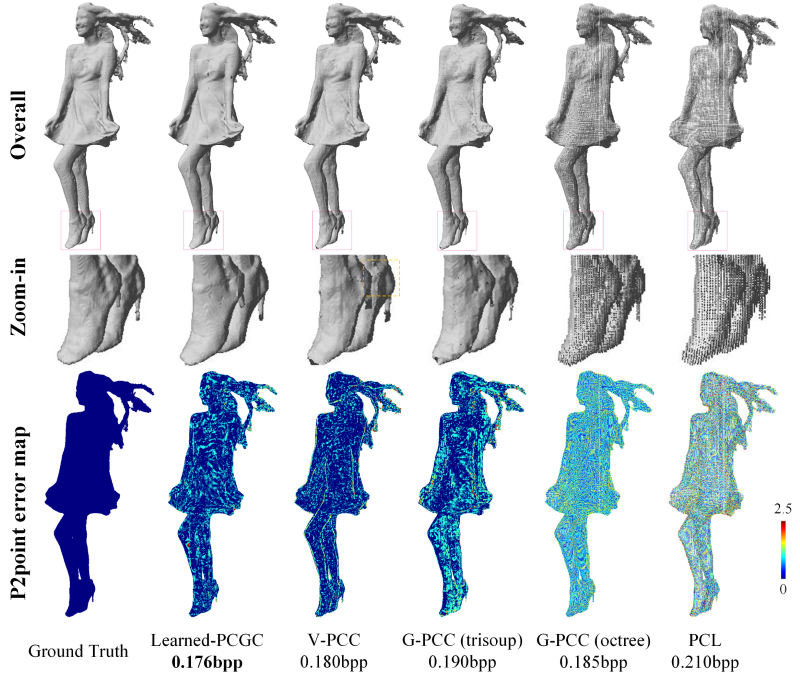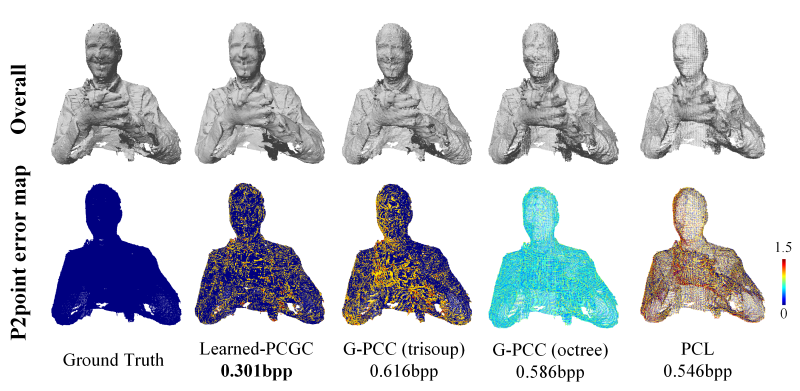Jianqiang Wang, Hao Zhu, Haojie Liu, Zhan Ma. [arXiv]
PCGCv2: Multiscale Point CLoud Geometry Compression [arXiv] [github]
An illustrative overview in (a) and detailed diagram in (b) for point cloud geometry compression consisting of a pre-processing for PCG voxelization, scaling & partition, a compression network for compact PCG representation, and metadata signaling, and post-processing for PCG reconstruction and rendering. “Q” stands for “Quantization”, “AE” and “AD” are Arithmetic Encoder and Decoder respectively. “Conv” denotes the convolution layer with the number of the output, channels, and kernel size.
- ubuntu16.04
- python3
- tensorflow-gpu=1.13.1
- Pretrained models: http://yun.nju.edu.cn/f/2a54abc9e8/
- ShapeNet Dataset: http://yun.nju.edu.cn/f/6d39b9cba0/
- Test data: http://yun.nju.edu.cn/f/e200741271/
python test.py compress "testdata/8iVFB/longdress_vox10_1300.ply" \
--ckpt_dir="checkpoints/hyper/a6b3/"python test.py decompress "compressed/longdress_vox10_1300" \
--ckpt_dir="checkpoints/hyper/a6b3/"Other default options: --scale=1, --cube_size=64, --rho=1.0, --mode='hyper', --modelname='models.model_voxception'
Please refer to demo.ipynb for each step.
python eval.py --input "testdata/8iVFB/longdress_vox10_1300.ply" \
--rootdir="results/hyper/longdress/" \
--cfgdir="results/hyper/8iVFB_vox10.ini" \
--res=1024The results can be downloaded in http://yun.nju.edu.cn/f/b413edb458/
sampling points from meshes, here we use pyntcloud (pip install pyntcloud)
cd dataprocess
python mesh2pc.pyThe output point clouds can be download in http://yun.nju.edu.cn/d/227493a5bd/
python generate_dataset.pythe output training dataset can be download in http://yun.nju.edu.cn/d/604927e275/
python train_hyper.py --alpha=0.75 \
--prefix='hyper_' --batch_size=8 --init_ckpt_dir='checkpoints/hyper/a0.75b3' --reset_optimizer=1or
python train_factorized.py --alpha=2 \
--prefix='voxception_' --batch_size=8 --init_ckpt_dir='./checkpoints/factorized/a2b3' --reset_optimizer=1results.ipynb
- 2019.10.09 initial smbmission.
- 2019.10.22 submit demos, several pretrained models and training datasets.
- 2019.10.27 submit all pretrained models and evaluate on 8i voxelized full bodies.
- 2019.11.14 check bug and start testing on AVS PCC Cat3.
- 2019.11.15 test point cloud sequences using avs metric tool. (thanks for the help from Wei Yan)
- 2019.11.19 finish testing AVS Cat3.
- 2019.11.20 test AVS Cat2.
- 2019.11.26 test AVS single frame.
- 2019.11.31 doc.
- 2020.06.27 python3 & clean up.
- 2020.10.03 open source.
- 2020.12.09 ablation studies & experiment configuration.
- pytorch version & tensorflow2.0 version.
- training again.
These files are provided by Nanjing University Vision Lab. And thanks for the help from SJTU Cooperative Medianet Innovation Center. Please contact us ([email protected]) if you have any questions.



